Cobble stoned alleyway-like streets lined with wall-to-wall bright teal, orange, and yellow stuccoed homes, shops clad with wrought iron gated windows, and sorely chipped tiled entryway steps make up the neighborhoods. Stumbling along chunks of concrete uprooting from sidewalks, zigzagging in and out of clusters of vendors carrying baskets of goods, scurrying women with children in tow, bicycle drawn carriages, and cars driven by madmen who always have the right of away, we make it safely to a local restaurant where we finally have our late lunch after a long, hellish red-eye.
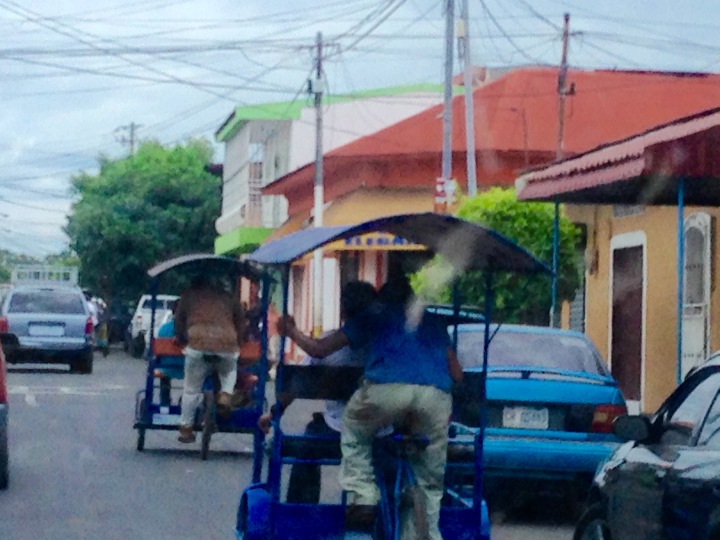
In Chinandaga, Nicaragua’s fifth largest city, every other home’s living room serves as a pulperia (mini convenient store), farmacia, sastrería (tailor’s), specialty shop, or restaurante. Popular fast food chains such as Tip Top, the fried chicken, papas, and plantain palace centered around a children’s ball pit, can be found in the heart of the city. A Pizza Maria’s, featuring American style pizza and greasy fried chicken, and a posh little deli that sells Stone IPA’s for five bucks a pop, entices travelers and wealthy locals. But when I step off the plane in Managua and finally make it to Chinandaga two hours later, it’s time to get me some gallo pinto along with the usual Nicaraguan fixin’s.
Along the narrow streets of Chinny, we look for mini-restaurants set in the forefront of homes, furnished with delicate café tables and plastic chairs, smoking barbecue grills under enormous black sooted vents, coolers filled with gaseosas (sodas), and displays of ready-to-serve side dishes behind plexiglas windowed wagons. Some of these local style restaurants have grown their walls and now take up entire lots due to popularity, especially with tourists, who once only trickled in, but now traverse through the town regularly in large groups. Eager to stay off the beaten track, we stick with the lesser known areas, hoping that my looks and lack of Spanish, and R’s Spanish and lack of native features, will somehow blend in.
In the open air, un-air-conditioned eateries, the usual order is gallo pinto, pollo asado, plátano maduros, and ensalada de repollo. Even in the heat and humidity, one works up an appetite! Other choices of sides might include steamed vegetables, boiled yuca, chicharrón, thick corn tortillas, and tostones.
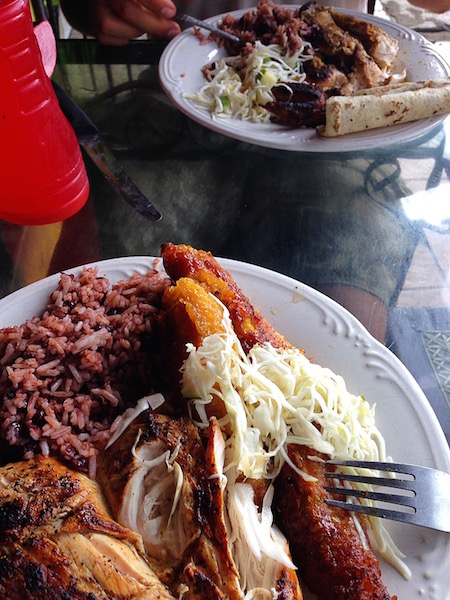
Gallo pinto is Nicaraguan rice and beans consisting of fresh red beans (small Nicaraguan kidney beans) boiled for hours, mixed with white rice, and seasoned with bell pepper, onion, oil, salt, and pepper. Gallo pinto actually means “spotted rooster” for the way the dish looks. Its origin is unknown, although there is some speculation that it was introduced hundreds of years ago by slaves brought from Africa. The dish is also very popular in Costa Rica, just south of the border.
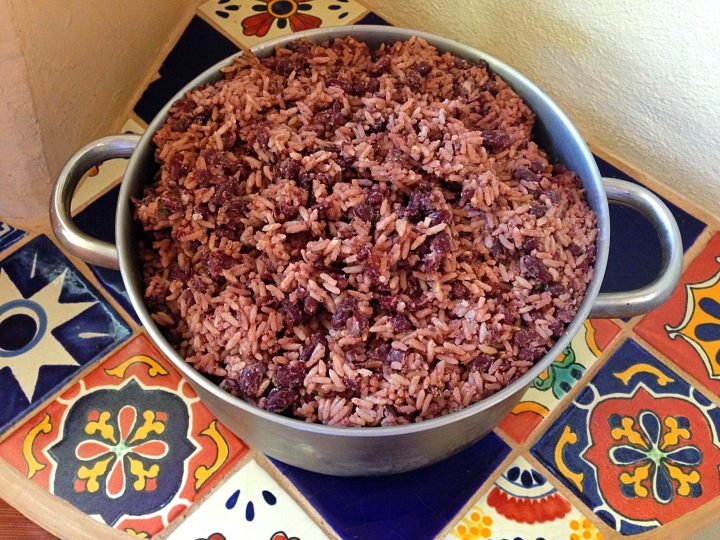
Pollo asado is barbequed chicken with a delicious smoky flavor combined with salt and oil.
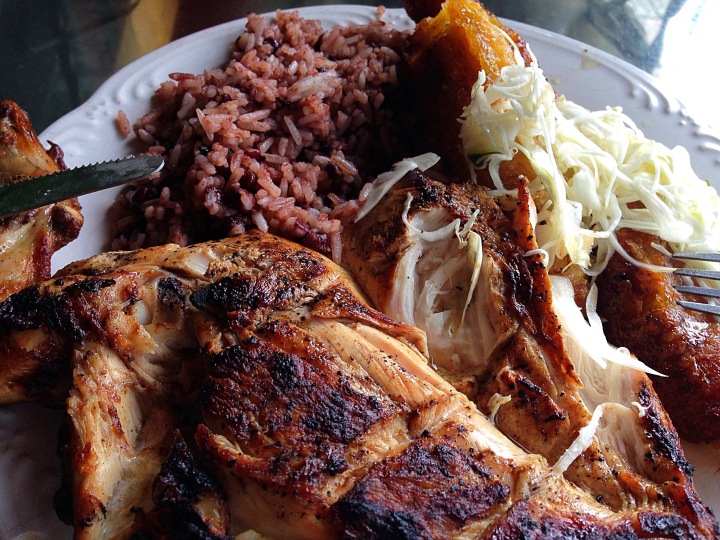
My favorite, plátano maduros, are sweet ripe plantains, so ripe that their skins are black on the outside. These are peeled, cut, and fried in oil. For me, it’s dessert with my entrée –and this makes me smile every time! Tostones are the same plantains, but prepared when the skin is still green- way under ripe. These are thinly sliced and fried into salted banana chips. Both ways are very tasty, and addicting!
Ensalada de repollo is a simple fresh cabbage salad with bits of chopped carrots, onions, and chile pepper, marinated in vinegar and salt.
Boiled yuca (cassava) is a widely and often eaten staple in Nicaragua, served in a traditional dish called Baho. Baho is yuca, beef, and plantains wrapped in banana leaves and boiled for hours. Since cooking this dish is almost a two day affair, families reserve its preparation for Sundays, parties, and special events.
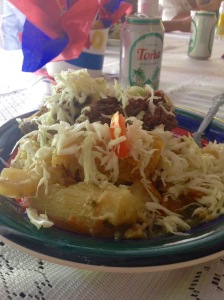
Chicharrón is, yep you guessed it, fried pork skin.
Nicaragua offers plenty of simple, fresh, and unique dishes, but gallo pinto is my foundation. Being Mexican and Puerto Rican, the smell of rice and beans, although much different between the two cultures, always permeated the kitchen air in my abuelas’ kitchens. For me, it’s a comfort food that brings me home no matter where I’m at. Although, essentially still a stranger in Central America, I began feeling more at home through the food. And just like in my families’ kitchens, home is the best place to have rice and beans.
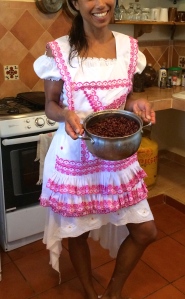
Asseradores, a small village about an hour outside of Chinny, is the home of Ruth and her family. Her wood fire stove in the outdoor kitchen rages with smoke and flames, cooking up the family’s daily meal of gallo pinto. Day old beans are usually eaten with rice while the new batch boils in a huge iron pot. In Costa Rica, the word gallo is also means “leftovers”.
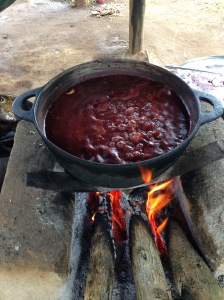
The village also has café style restaurants that serve gallo pinto with their dishes- Don Pedro’s also offers a variety of refreshing tropical smoothies.

However, nothing I’ve tasted in Nicaraguan living room cafes and upscale restaurants compares to the gallo pinto in Ruth’s kitchen. This is the good stuff that completely satisfies my rice and beans craving and makes me feel at home.












Great tempting foods. Maybe it’s cooking the gallo pinto over an open fire.
LikeLiked by 1 person
Totally! Gives that authentic flavor you don’t get on a stovetop.
LikeLike